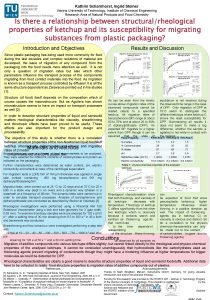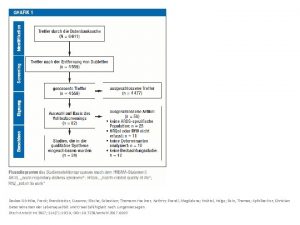Kathrin Scharnhorst Ingrid Steiner Vienna University of Technology

- Slides: 1

Kathrin Scharnhorst, Ingrid Steiner Vienna University of Technology, Institute of Chemical Engineering Research Area of Natural Products and Food Chemistry Is there a relationship between structural/rheological properties of ketchup and its susceptibility for migrating substances from plastic packaging? Introduction and Objectives Results and Discussion Since plastic packaging has being used more commonly for food during the last decades and complex solutions of material are developed, the issue of migration of any compound from the packaging into the food needs more attention as well. It is not only a question of migration rates but also which other parameters influence the transport process of the components migrating from food contact materials into the food. As migration is known as a transport process controlled by diffusion it is all the same structure dependent as Zaravacos pointed out in his studies [1]. Structure (of food) itself depends on the composition which of course causes the macrostrucure. But as Aguilera has shown microstructure seems to have an impact on transport processes as well [2]. In order to describe structure properties of liquid matters rheological characteristics like viscosity, and thixotropic effects have been proved to be effects are also important for the product processability. and semisolid shearthinning useful. These design and The objective of this study is whethere is a correlation between structure properties of the non-Newtonian liquid foodstuff ketchup (rheologically determinable and others) and migration Materials and Methods rates of 2 model Several ketchups were at local film. supermarkets to be analysed. contaminants out ofpurchased a LDPE plastic As can be seen from the kinetic curves above migration rates of the examined compounds cannot be related clearly to a specified ketchup. All migration rates of benzophenone (BP) range at about 60 to 70% and at about 20 to 30% of diphenylphthalate (DPP). As expected BP migrates to a higher extent than DPP though it can be assumed that the state of They were selected for differernt contents of carbohydrates and protein as indicated on the packaging. equilibrium is not reached during the observed time range in the case of DPP. Only migration of DPP at 70°C seem to distinguish the different ketchups where ketchup C shows the least susceptibility for DPP. Summarizing all results it does not seem to make a big difference, whether the sample is agitated or not while in contact with the material. Food Property Ketschup A Ketchup B Ketchup C % Protein % Carbohydrates % Water p. H Refractive index (22°C) Electric conductivity 1, 5 2, 2 1, 5 29 35 20 67 69 73 3, 7 3, 9 1, 3879 1, 3859 1, 3757 16, 5 m. S/cm 8, 2 m. S/cm 9, 6 m. S/cm Table 1: physico-chemical properties of the analysed ketchups Further characteristics were determined as water content, p. H, electric conductivity and refractive index of the centrifugal supernatant. For migration tests a LDPE film of 164 µm thickness was applied in single side contact containing 450 mg benzophenone and 561 mg diphenylphthalate/kg film. Migration tests: were carried out at 25 °C for 22 days and at 70°C for 25 h both in a static way (kept in an oven) and a dynamic way (shaken in a waterbath at a frequency of 80/min. The dynamic tests were carried out in order to simulate transport processes. Analysis of benzophenone and diphenylphthalate was conducted as described by Steiner et Volansky [3]. Rheological investigations were performed using a Rheomat RM 180 Rotational Viscosimeter using a bob and tube geometry No 3 (gap width: 0, 59 mm). To examine thixotropy samples were pre sheared for 120 s at 50 s-1, after a settling time of 30 min shearing from 6. 5 to 300 s-1 in 45 s forth and backwards was conducted. Shearthinning and flow behaviour were investigated performing a step test with ramps at 10 – 20 – 40 – 80 – 200 – 300 – 500 – 750 – 1000 s-1 also after pre shearing for 120 s at 50 s -1 and a 30 min settling time. Rheological characterisation show that both thixotropy and viscosity of all ketchups decrease with temperature, Thixotropy of ketchup C differs significantly from the other two ketchups which is obviously because it contains starch and xantha n as thickeni n g ag e nts that contri b ute to the time depende n t reassembling of the structure. Shear thi nning can be observed for all samples as Conclusions can be expected of food that show pseudoplastic behaviour, higher temperature influences shear thinning in a positive direction as well. The impact of thickening agents (as in ketchup C) on viscosity is obvious and distinct. So far a correlation to the physicochemical characteristics can only be made out to the content of carbohydrates (sugars and /or thickening agents). Migration of additive compounds into various ketchups differs slightly, but cannot linked directly to the rheological and physico-chemical properties of the analysed ketchups. It cannot be concluded unambiguously that hydrocolloids like the carbohydrates used as thickening agents prevent migrating of contaminants though they might have a hindering influence at higher temperatures for bigger molecules as could be detected for DPP. Rheological characteristics are clearly a good means to describe structure properties of liquid and semisolid foodstuffs. Additional data have to be collected to relate food structure properties to migration rates of additive compounds out of plastics. References Acknowledgements [1] Saravacos, G. D. : Transport properties of foods, New York, Dekker, 2001 [2] Aguilera, J. M. : Why food microstructure, Journal of Food Engineering, 2005, 67, p 3 -11 [3] Steiner, I. , Volansky, P. : Determination of diphenylphthalate and benzophenone in foodstuffs; in: "Compilation of analytical methods for model migrants in foodstuffs", P. Paseiro Losada, C. Simoneau, R. Franz (Hrg. ); European Commission, Directorate General, Joint Research Center, Ispra, 2006, EUR 22232 EN, p. 51 - 66. Thanks to Mark Wingfield, Malvern Instruments Gmb. H, Germany, for giving valuable introduction and advice into practical rheology. Contact: Kathrin. Scharnhorst@tuwien. ac. at Funding for this research was provided by the f. FORTE WIT - Women in Technology Program of the Vienna University of Technology. This program is co-financed by the Vienna University of Technology, the Ministry for Science and Research and the f. FORTE Initiative of the Austrian Government.

